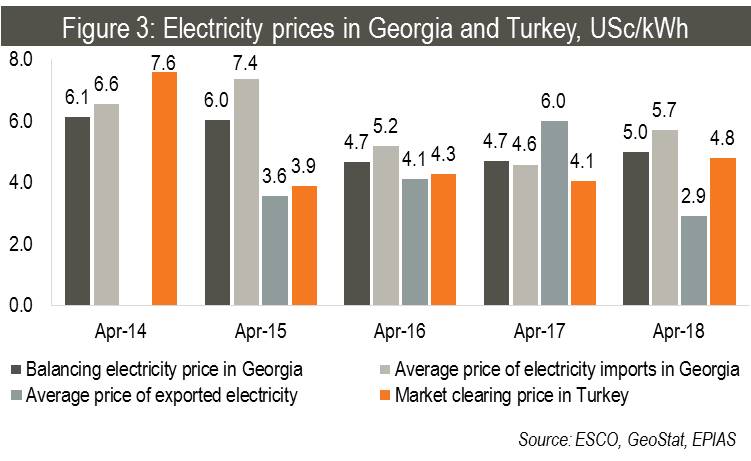May: Electricity Market Watch
Sector research is one of the key directions of Galt & Taggart Research. We currently provide coverage of Energy, Healthcare, Tourism, Agriculture, Wine, and Real Estate sectors in Georgia. As part of our energy sector coverage, we produce a monthly Electricity Market Watch, adapted here for Georgia Today’s readers. Previous reports on the sector can be found on Galt & Taggart’s website - gtresearch.ge.
Annual forecast for 2018 electricity balance revised
The 2018 electricity balance forecast was approved by Ministry of Economy and Sustainable Development in December 2017. The document outlines the generation and consumption plans for each market participant. The updated annual forecast of 2018 electricity balance was issued on May 16, 2018.
Electricity consumption expected to increase by 6.9% y/y in 2018. The updated annual forecast of 2018 electricity balance was issued on May 16, 2018. Main modifications are related to export and import amounts, hydro generation and 4M figures (forecasted replaced by actuals).
According to the modified annual forecast for 2018: Electricity consumption expected to reach 12.7TWh (growth revised down to 6.9% y/y from 7.1%y/y in previous edition); Import expected to reach 1.3TWh, which is 12.4% y/y reduction compared to initial forecast of 30.8% y/y increase; Export planned at 0.5TWh. GSE should define the exporter companies and export directions by the public auctions. So far, the most popular direction within exporters remains Turkey and Armenia is second most popular market.
Electricity supply and demand in 4M18
Electricity consumption increased by 6.7% y/y to 4.3TWh in 4M18. The increase was mainly driven by the 8.4% y/y growth in consumption of distribution licensees due to addition of new commercial subscribers (Energo-pro’s consumption was up by 9.7% y/y and Telasi’s was up by 6.1% y/y). Consumption by Eligible consumers and Abkhazian region was down respectively by 8.5% y/y and 5.0% y/y in 4M18.
Domestic generation was up by 20.6% y/y in 4M18, mainly driven by 39.8% y/y increase in hydro generation. This dramatic increase in hydro generation can be explained by last year’s low base and by the good hydrological conditions.

The surplus in hydro Generation (19.5% over the planned level) in 4M18 reduced thermal generation (-16.8% y/y) and imports (-38.9% y/y), both being significantly below the planned levels (17.8% and 40.6% respectively).
Electricity imports stood at 0.5TWh (US$ 27.9mn) in 4M18. The 88.6% of total imports came from Azerbaijan, while the rest came from Turkey (6.7%) and Russia (3.3%).
Unexpected surplus in hydro generation also resulted in unexpectedly early exports of electricity. Export of electricity started in second half of April and reached 61.7GWh (US$ 1.8mn) in 4M18.
Electricity consumption and generation – April 2018
Domestic electricity consumption increased 5.0% y/y to 1.0TWh in April 2018. The main contributors to the overall consumption growth were distribution licensees (+13.8% y/y), driven by addition of new commercial subscribers. Consumption by Abkhazian region and eligible consumers was down by 13.2% y/y and 14.5% y/y respectively, contributing negatively (-4.4ppts) to the overall growth of consumption.
2018 export season started a bit earlier than usual - in second half of April, due to unexpected increase in hydro generation. Electricity exports reached 61.7GWh in April, 5.7% of total electricity supply. The largest exporter was Enguri HPP exporting electricity to Armenia (59.7% of total exports). The rest of surplus electricity was exported by ESCO to Russia (38.0% of exports) and Azerbaijan (2.3% of exports). There was no electricity transit in April 2018.

Electricity generated by domestic sources increased by 30.2% y/y to 1.1TWh in April 2018, 25.2% above the planned level. Hydro generation showed significant increase (+41.1% y/y) in April 2018, 21.9% the planned level: 1) Enguri/Vardnili generation more than doubled increasing by 135.4% y/y. This significant increase can be explained by good hydrological conditions and last year’s low base (-13.8%). Notably, in April 2018, Abkhazian region consumed only 35.7% of electricity generated from Enguri/Vardnili, for comparison this share equaled 96.9% in April 2017. 2) Generation of other regulated and deregulated HPPs also increased by 6.0% y/y and 17.0% y/y, respectively, due to high water flow and addition of new HPPs (Dariali and Khelvachauri) to the group of deregulated HPPs.
The surplus in hydro generation reduced thermal generation (-58.6% y/y) and imports (-92.3% y/y). Electricity imports almost halved (-92.3% y/y) to 11.2 GWh in April 2018 and accounted for only 1.0% of total supply. Most of the imported electricity came from Russia (87.3% of total), while the rest came from Azerbaijan.
The guaranteed capacity fee was down 7.8% y/y to USc 0.73/kWh in April 2018, due to increase in consumption, which serves as a base for guaranteed capacity fee calculation. Guaranteed capacity was provided by all five sources for entire month, with only Gardabani CCGT operating for the first decade of the month, while other thermal power plants being mostly on standby.
Electricity prices in Georgia and Turkey
The average import price increased by 24.2% y/y and reached USc 5.7/kWh in April 2018, from USc 4.6/kWh in April 2017. This growth can be explained by last year’s low base, when there was a subsidized electricity import from Russia via Salkhino line to satisfy the excess needs of Abkhazian region.
Despite higher import price, the wholesale market price increased only by 5.0% y/y to USc 5.0/kWh, due to low electricity imports. Electricity traded at the wholesale price through the market operator was 17.7% of total electricity supplied to the grid, down from 26.0% in April 2017.
The average price of electricity in Turkey was up 18.8% y/y to USc 4.8/kWh, 3.8% below the wholesale market price in Georgia.
The average export price was USc 2.9/kWh in April 2018. We assume the low average price of export is due to high share (38.0%) of exports to Russia at significantly low price, and the barter of electricity agreed by ESCO in February 2018.

By Mariam Chakhvashvili











